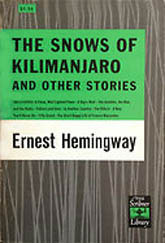The Snows of Kilimanjaro
Critique • Quotes • At the movies
 1961 collection
1961 collectionFirst publication
1936 in Esquire magazine
First book publication
1938 in The Fifth Column and the First Forty-Nine Stories (1938)
Literature form
Story
Genres
Literary
Writing language
English
Author's country
United States
Length
Approx. 8,500 words
Portrait of the artist as a dying man
It's not the story I would pick as Ernest Hemingway's best. I have a thing against writers writing about being writers, particularly writers writing about being writers being unable to write.
But "The Snows of Kilimanjaro" is a particularly good one in that self-absorbed genre. And it has turned out to be one of the most celebrated Hemingway stories.
Much of the appeal of "The Snows of Kilimanjaro" has got to be the strangely moving ending as the writer dying of an infected leg on an African hunting safari has one final fantasy that I won't spoil here.
But even on repeated readings, the story holds up. The writer's regrets and his yearning for earlier days as he rambles mentally through his famous career and adventures reveal Hemingway more vulnerably than most of his other stories.
The story first appeared in a magazine in 1936 and was republished a couple of years later in The Fifth Column and the First Forty-Nine Stories, but such has been its fame that it is usually found in a collection to which it gives the title: The Snows of Kilimanjaro and Other Stories.
Standout stories
Also included in that collection is another famous safari-set tale, "The Short Happy Life of Francis Macomber", the story of a cowardly American and his mocking wife who takes up with a real hunter.
Other stories standing out in this collection include the very short, simple and classic Hemingway piece "A Clean Well-Lighted Place", in which nothing much happens apart from two waiters watching a drunk while waiting to close a restaurant, and "The Killers", which in ten pages hints at an entire novel of events behind the story of a wealthy man awaiting assassins he knows are coming.
For some reason, filmmakers have been drawn to try filming the seemingly non-cinematic stories of this period of Hemingway's career. "The Killers" was stretched into a film starring Burt Lancaster in 1946 and again with Lee Marvin and Ronald Reagan in 1964. "The Short Happy Life of Frances Macomber" became The Macomber Affair in 1947 with Gregory Peck as the hunter and Robert Preston as the ill-fated Macomber.
"The Snows of Kilimanjaro" was made into a 1952 movie starring Peck again and changing not only much of the dying writer's memories but Hemingway's marvellous ending.
Even the very short "A Clean Well-Lighted Place" was somehow filmed in 2002.
— Eric
Critique • Quotes • At the movies

